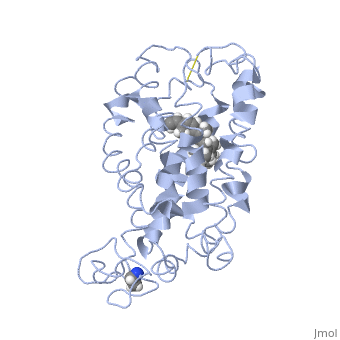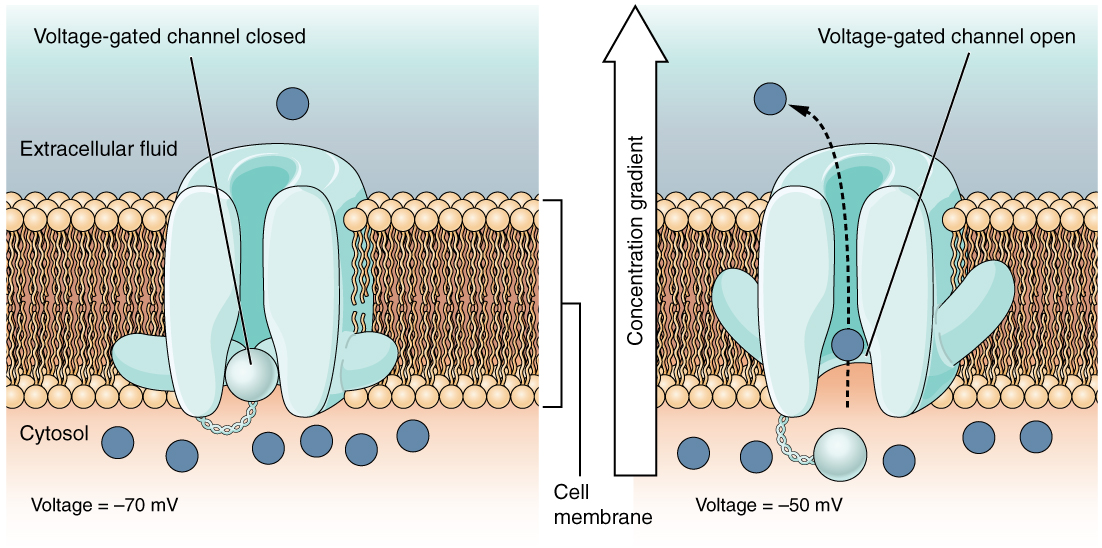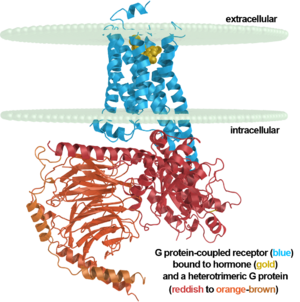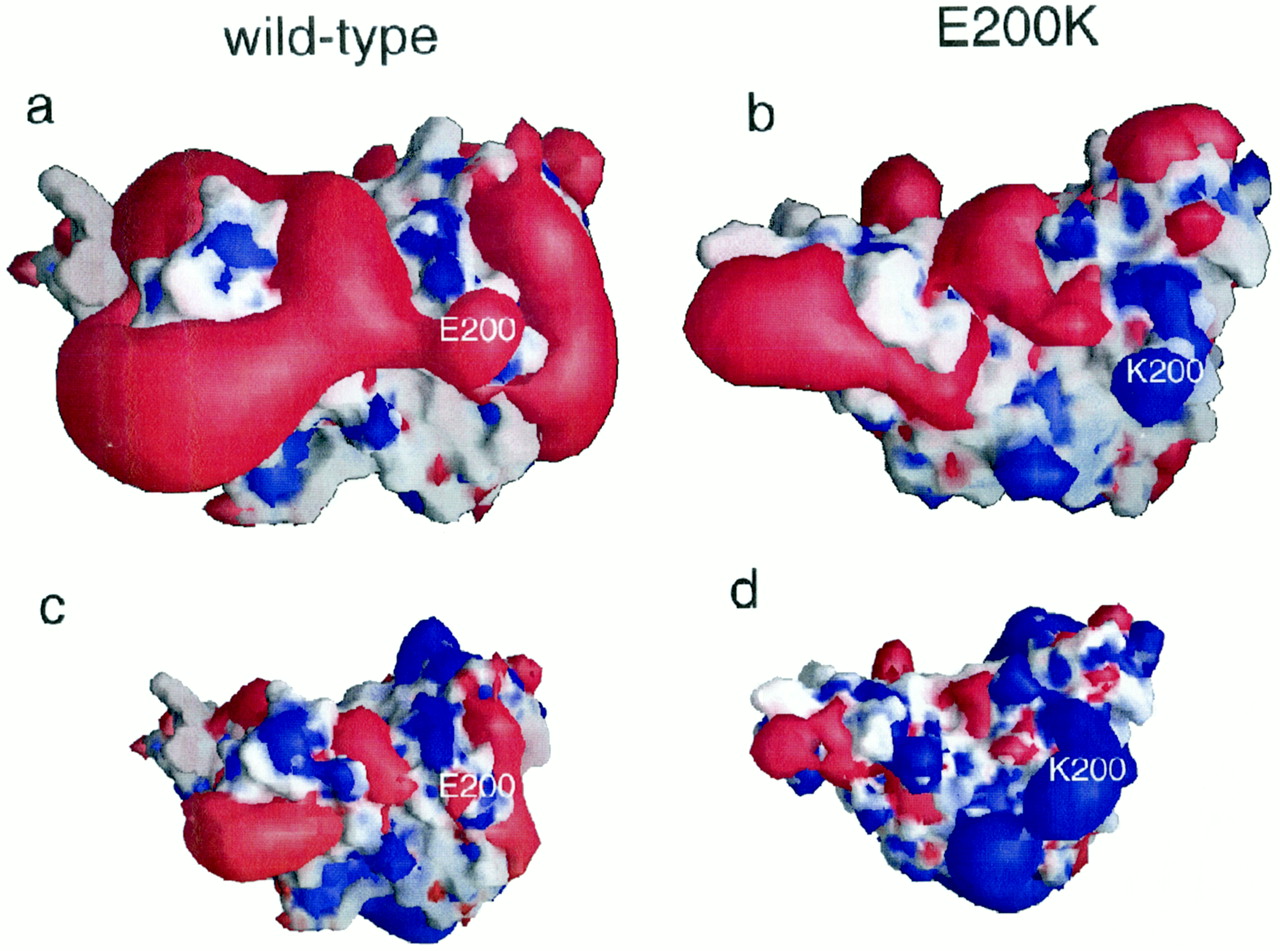Sandbox Reserved 1451
From Proteopedia
(Difference between revisions)
| Line 19: | Line 19: | ||
== Function == | == Function == | ||
| - | Rhodopsin performs two functions. One function is to bind retinal. | + | Rhodopsin performs two functions. One function is to bind retinal. Rhodopsin is a protein that is essential for vision, especially in dim light. The photoreceptors in the retina that contain rhodopsin are rods. Rhodopsin is attached to 11-cis retinal which becomes excited by a photon of light and isomerizes to become all-trans conformation (NOTABILITY). This excitation activates rhodopsin and leads to depolarizing of neurons. The depolarizing of neurons is how the image is transmitted to the brain. (https://ghr.nlm.nih.gov/gene/RHO#) Another function is to function as a G protein-coupled receptor. When rhodopsin is activated by light the protein couples with the G protein transducin which is the first step in the signal cascade (PDF ON NOTABILITY) Rhodopsin must undergo several conformational changes before being able to bind transducin. (ALTERATIONS) Rhodopsin is initially converted to metarhodopsin II which is the active form of rhodopsin. Once the protein is active then metarhodopsin binds the G-protein tranducin and the GDP is exchanged for GTP. The G protein subunits dissociate and causes a decrease in cytosolic cGMP. The decrease in cGMP also causes the closing of calcium channels. When calcium concentrations drop the photoreceptors become hyperpolarized and this ensures the action potential is sent onward toward the brain. (RHODOPSIN AND RP). Photoreceptors are unable to be immediately restimulated, rhodopsin kinase phosphorylates the protein on serine and threonine residues which leads to the binding of arrestin. Arrestin prevents rhodopsin from interacting with tranducin again, thus preventing restimulation of the protein. Arrestin is released from the protein via phospotase A which dephosphorylates rhodopsin. (RHODOPSIN AND RP)[[Image:Example.jpg]] |
== Disease == | == Disease == | ||
| - | Mutations to rhodopsin can lead to stationary night blindness or retinitis pigmentosa. | + | Mutations to rhodopsin can lead to stationary night blindness or retinitis pigmentosa. |
''Autosomal Dominant Congenial Stationary Night Blindness'' | ''Autosomal Dominant Congenial Stationary Night Blindness'' | ||
| Line 28: | Line 28: | ||
''Retinitis Pigmentosa'' | ''Retinitis Pigmentosa'' | ||
| - | Retinitis pigmentosa is also an autosomal dominant disorder, but can also be recessive in rare circumstances. A mutation that affect rhodopsin that cause retinitis pigmentosa result in a misfolding or transportation of the protein. Another mutation to rhodopsin can affect the activation of the protein in response to light. These mutations can lead to apoptosis of rods in the retina. Without rods to perceive dim light, night blindness results. | + | Retinitis pigmentosa is also an autosomal dominant disorder, but can also be recessive in rare circumstances. There are two main classes of mutations that cause retinitis pigmentosa, class I and class II. (NOTABILITY) A mutation that affect rhodopsin that cause retinitis pigmentosa result in a misfolding or transportation of the protein. Class I mutations are commonly associated with a defect in the C-terminus of the protein which results in defective trafficking of the protein. (NOTABILITY) Class II mutations are commonly associated with the N-terminus of the protein and results in misfolding in the endoplasmic reticulum. (NOTABILITY) Another mutation to rhodopsin can affect the activation of the protein in response to light. These mutations can lead to apoptosis of rods in the retina. Without rods to perceive dim light, night blindness results. |
(https://ghr.nlm.nih.gov/gene/RHO#) | (https://ghr.nlm.nih.gov/gene/RHO#) | ||
| + | |||
== Relevance == | == Relevance == | ||
[[Image:7tm labeled.png|right|300px]] | [[Image:7tm labeled.png|right|300px]] | ||
| - | Up until 2007, rhodopsin was the only GPCR that had a high-resolution crystal structure and was the basis for other GPCR structures. (https://www.ncbi.nlm.nih.gov/pubmed/24041646) | + | Up until 2007, rhodopsin was the only GPCR that had a high-resolution crystal structure and was the basis for other GPCR structures. (https://www.ncbi.nlm.nih.gov/pubmed/24041646) Most G-protein coupled receptors are a target for pharmaceutical companies as the receptors are involved in a variety of physiological and pathophysiological processes. (ALTERATIONS) Most GPCRs bind ligands with an open domain. Rhodopsin and other vision proteins are unique as the proteins acquire ligands via transient pores in that open between the transmembrane helices of the GPCR. The use of transient pores allows thermal stability of the rhodopsin protein. (NOTABILITY) |
| + | [[Image:F4.large.jpg]] | ||
== Structural highlights == | == Structural highlights == | ||
| - | This is rhodopsin without 11-cis retinal bound.<scene name='77/778331/Rhodopsin/1'>Rhodopsin</scene> | + | This is rhodopsin without 11-cis retinal bound.<scene name='77/778331/Rhodopsin/1'>Rhodopsin</scene> Fully functional rhodopsin has the typical GPCR structure of a seven transmembrane helical bundle with the N-terminus on the interior of the rods and the C-terminus in the cytoplasm. The N-terminus is located near the extracellular loops and ends of the transmembrane protein. There are hydrogen bonding between the transmembrane sections and the extracellular loops that are involved in the activation of rhodopsin when a photon is received. The N-terminus is thought to play a role in orientation of the extracellular loops. (NOTABILITY) Transmembrane domain 1 and 2 play a role in stabilizing the protein and giving the protein functionality. (ALTERATIONS) Rhodopsin has two components: opsin (a membrane-bound polypeptide) and 11-cis-retinal (a chromophore that is bound to opsin via a protonated Schiff-base). (RHODOPSIN AND RP) |
| - | This is 11-cis retinal that rhodopsin binds.<scene name='77/778331/11-cis retinal/1'>11-cis retinal</scene> | + | This is 11-cis retinal that rhodopsin binds.<scene name='77/778331/11-cis retinal/1'>11-cis retinal</scene> 11-cis retinal is the ligand, a molecule that is derived from vitamin A, is necessary for rhodopsin function. The ligand performs an inverse agonist suppressing activity on the photon receptor and is associated with the protein via protonated Schiff-bases linked to a lysine reside on the seventh domain (NOTABILITY). A negative agonist means the ligand, when present in the binding pocket of the protein, inhibits the receptor activity. (RHODOPSIN AND RP) The isomerization of cis to trans causes the protein complex to relax which allows for binding of transducin and the signal cascade to progress (ALTERATIONS). |
This is rhodopsin with 11-cis retinal bound.<scene name='77/778331/Rhodopsin bound 11-cis retinal/1'>Rhodopsin bound 11-cis retinal</scene> | This is rhodopsin with 11-cis retinal bound.<scene name='77/778331/Rhodopsin bound 11-cis retinal/1'>Rhodopsin bound 11-cis retinal</scene> | ||
Revision as of 01:04, 29 April 2018
>
| This Sandbox is Reserved from Jan 22 through May 22, 2018 for use in the course Biochemistry II taught by Jason Telford at the Maryville University, St. Louis, Missouri, USA. This reservation includes Sandbox Reserved 1446 through Sandbox Reserved 1455. |
To get started:
More help: Help:Editing |
| |||||||||||




